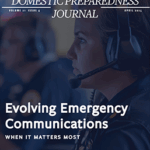Calls for help come in many forms: a family member encounters a loved one with a medical emergency; a sudden crash occurs on a highway; a fire ignites in an apartment complex; a woman goes into labor. Most people do not have the medical or public safety training to handle these types of situations. However, what is common knowledge is the phone number to dial in an emergency. In the United States, that number is 911.
Many people are not familiar with the operational details behind 911 calls: the location of the call center, the person who answers the call, and how field responders are dispatched and know where to go. These details are all managed in Emergency Communications Centers (ECCs). The public relies on the usually low-profile 911 centers despite not knowing where they are or what happens in them. In most jurisdictions, the public cannot access their local ECCs, which may reside in old grocery stores, basements of working courthouses, old industrial buildings, or in plain sight but are unrecognized. The unseen heroes inside those walls are public safety telecommunicators. Across the country, roughly 6,000 ECCs answer approximately 240 million 911 calls annually.
What Happens Within the Four Walls
Expectations at ECCs are high. All calls are treated as urgent and expected to be answered in 15 seconds or less to align with national standards. In addition to 911 calls from the public, law enforcement officers call in their traffic stops and receive case numbers from ECCs, and firefighters and emergency medical services personnel request additional units and resources. In short, the ECC is the central nervous system of local public safety, including highly trained and skilled public safety personnel. As the public’s initial contact for first responder services, ECC staff may have to talk frantic mothers through the steps of administering CPR to their non-breathing infants or reassure children who are unsure what to do after finding an unconscious parent or guardian.
While the heartbeat of any ECC is the frontline workers who answer the calls and dispatch the field units, there is often a person or a team of professionals handling the ECC’s behind-the-scenes physical and social infrastructure. The size of the team and support team frequently depends on the size of the jurisdiction and the type of services needed. Initial and ongoing planning updates are critical, especially in the 911 ecosystem, where standards constantly change, new technology emerges regularly, and laws and guidance evolve. In addition, there is a nationwide transition away from legacy 911 to Next Generation 911.
The amount of change and improvement occurring in the 911 space of the public safety ecosystem is monumental. Such changes can become problematic for centers if not managed and maintained sensibly and systematically. Solid strategic planning is essential to ensure cohesiveness. Since the 911 industry is constantly evolving, a strong plan is vital to avoid confusion and overlapping initiatives. When strategically planning for something so complex, the focus should be on three pillars of an ECC: the people, the training, and the technology.
ECC Strategic Planning
The support team is responsible for the day-to-day operations flow and the agency’s strategic plan. Any ECC’s strategic plan should be kept current and be dispersed and utilized throughout the community. The plan should highlight achievements, planning objectives, key performance measures, and necessary enhancements. The ECC is like a stool – operations are the seat, and the three legs that hold it up are the people, the training, and the technology.
People – This leg includes the community the 911 center serves and the people who do the work. So, there are two equally important angles to consider. Since emergency calls are inevitable, strategic plans must include the people who answer the calls. Focus areas include:
- Staffing levels and scheduling;
- Recruitment, retention, and pipeline bolstering;
- Training, certifications, and higher education;
- Customer service;
- Citizen engagement;
- Strong partnerships;
- Proper governance; and
- Retirement.
Training – This leg refers to the tools provided to the staff, partner agencies, and community to better understand how 911 works and what is needed to make the response system successful. Focus areas include:
- Initial training;
- Continuing education;
- Career advancement;
- Multi- or cross-agency training;
- Hot topic training (i.e., swatting training for 911 call takers); and
- Training policies.
Technology – This leg keeps the ECC running proficiently. It also enables the public to interact with 911 centers using their personal technologies, which include:
- Next Generation 911 (NG911) migration,
- Text-to-911,
- Enhancements to operations,
- Introduction of artificial intelligence,
- Mobile applications and texting capabilities,
- Video and streaming integration, and
- Cybersecurity.
Action Items
The 911 system celebrated its 56th anniversary on February 16, 2024. Considering public safety as a whole, 911 capabilities still have a lot of growth potential. Despite significant work and advancements in this space, much more work is necessary. In many cases, though, strategic planning is incumbent upon the localities. Although no comprehensive guide exists to lead ECCs in developing a strategic plan, examples from centers can assist and are an excellent place to start.
Strategic plans do not have to be long or complex. An initial plan can be a simple one-pager of goals with some strategies for meeting those goals. Over time, the one-pager can expand to include comprehensive long-term goals that span several years. As the ecosystem changes and needs increase, a strategic plan will assist the ECC in evaluating its capabilities and determining its future direction.
The 911 landscape constantly changes, and emergency technologies and threats like artificial intelligence, ransomware, and swatting attacks introduce new challenges. A current and flexible plan creates a firm foundation for navigating those challenges and changes.
Strategic planning is one of the best defenses to ensure robust emergency communications systems for local communities. For those who do not have a plan, take five minutes right now and write down three to five goals to accomplish in your center over the next year or two. Defining the goals is the first step in developing an ECC’s strategic plan. For those who already have a plan, take some time to review and update it. When an emergency happens, solid plans must be in place to ensure someone is there to answer calls for help and dispatch the necessary resources as quickly as possible.

Heather McGaffin
Heather McGaffin is the director of The Office of Unified Communications in Washington, DC. At sixteen, she began her public safety career as a volunteer emergency medical technician (EMT) at her local fire department and rescue squad. McGaffin has nearly 25 years of public and private sector experience in public safety, including as a field responder, call taker, dispatcher, and public safety communications expert. In February 2023, Mayor Muriel Bowser appointed her to lead the Washington, DC, Office of Unified Communications. She is also on the board of directors for the Next Generation 911 Institute.
- Heather McGaffinhttps://www.domesticpreparedness.com/author/heather-mcgaffin






